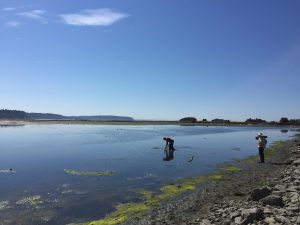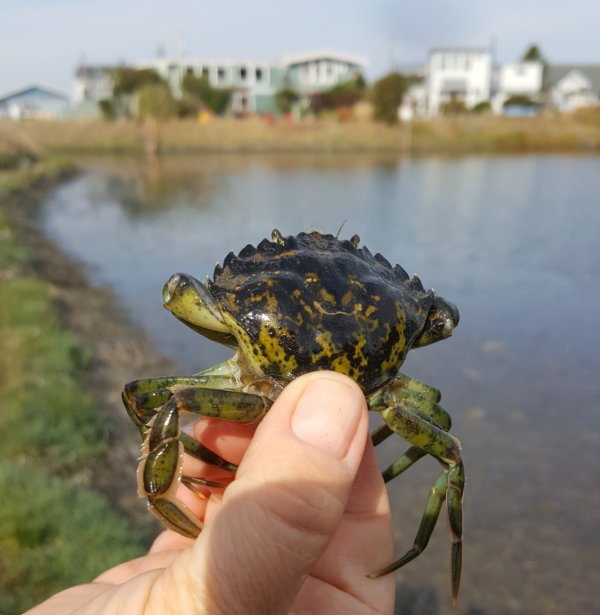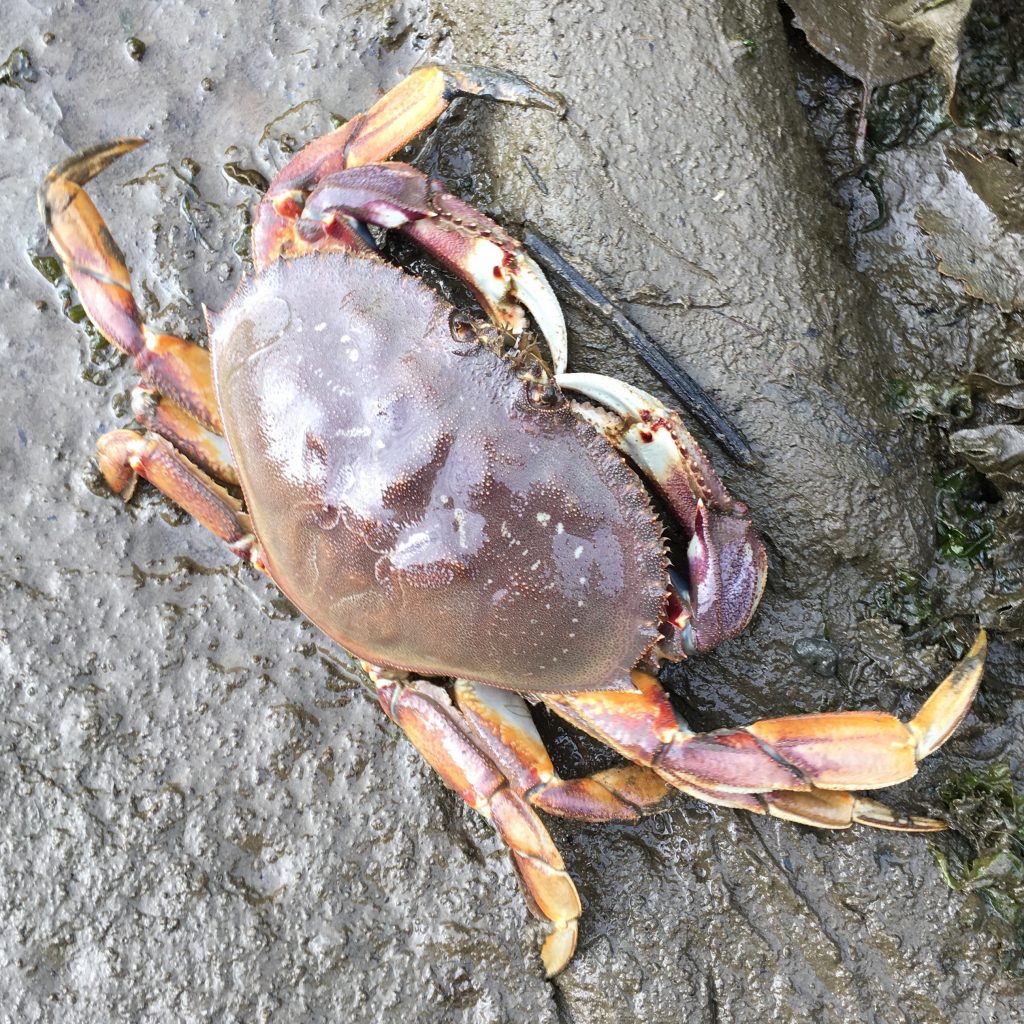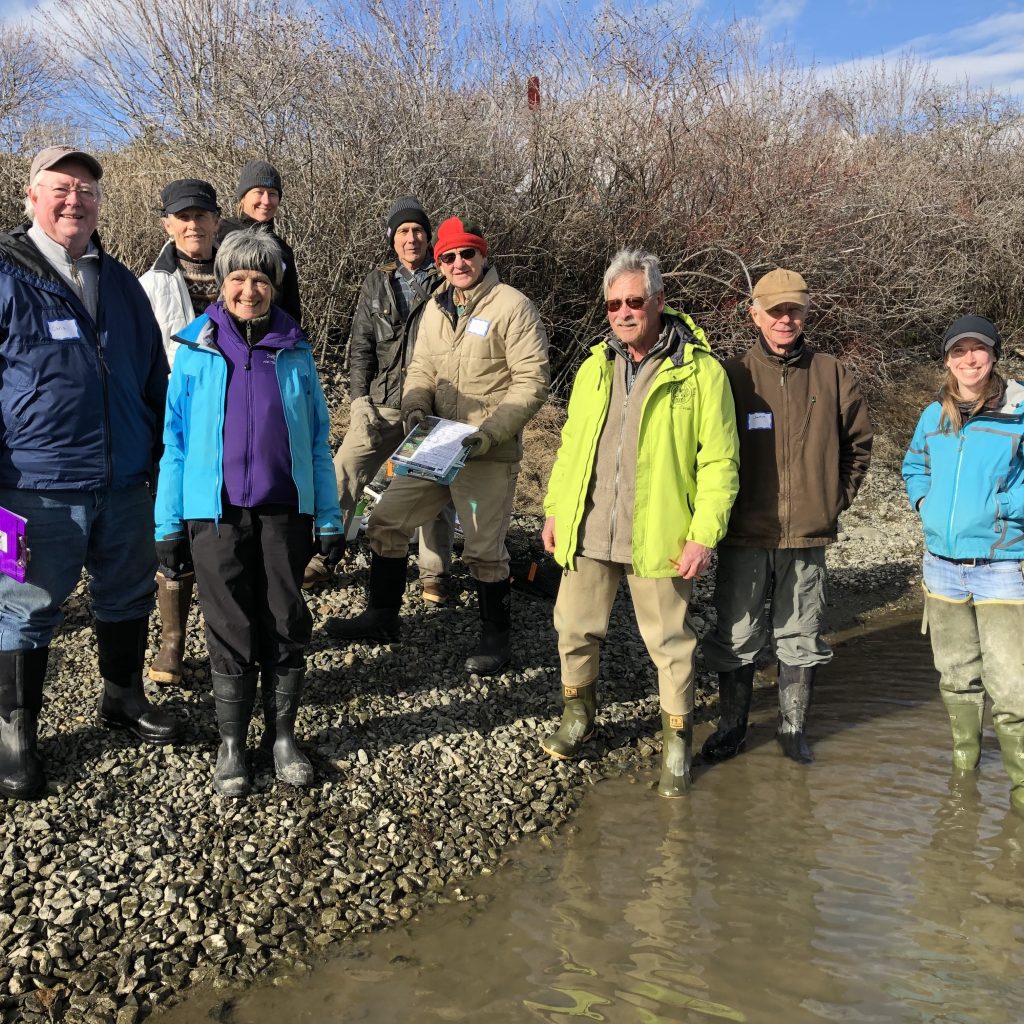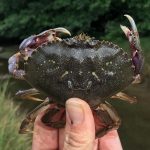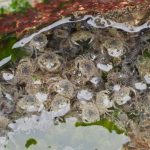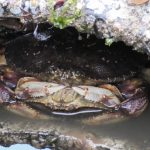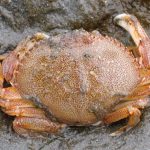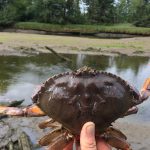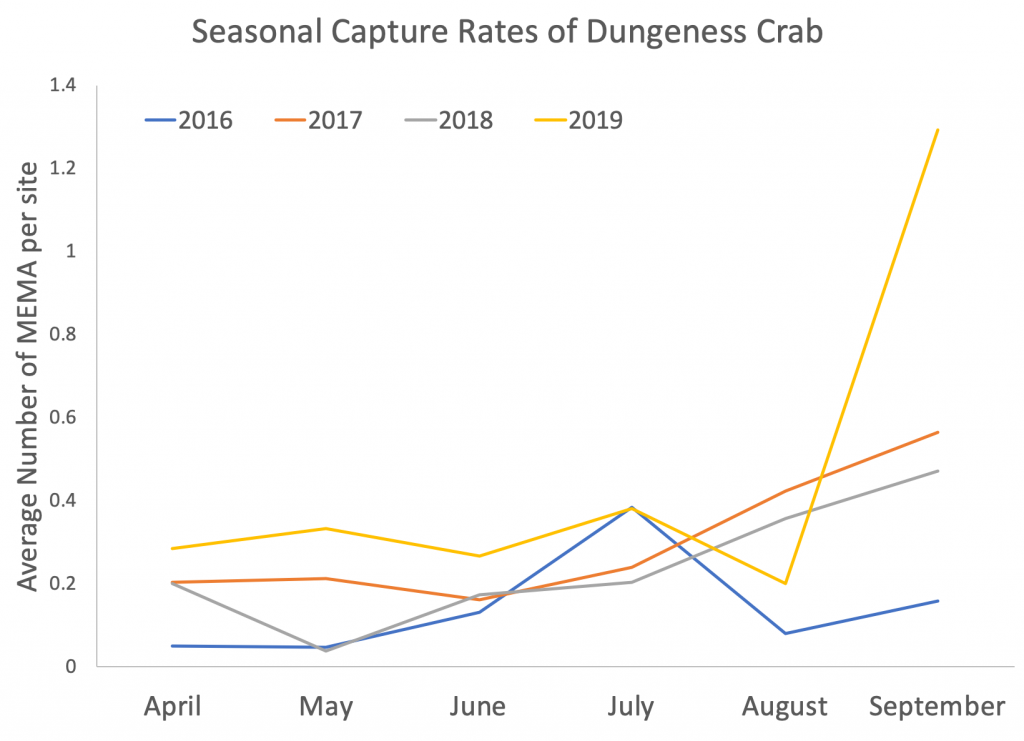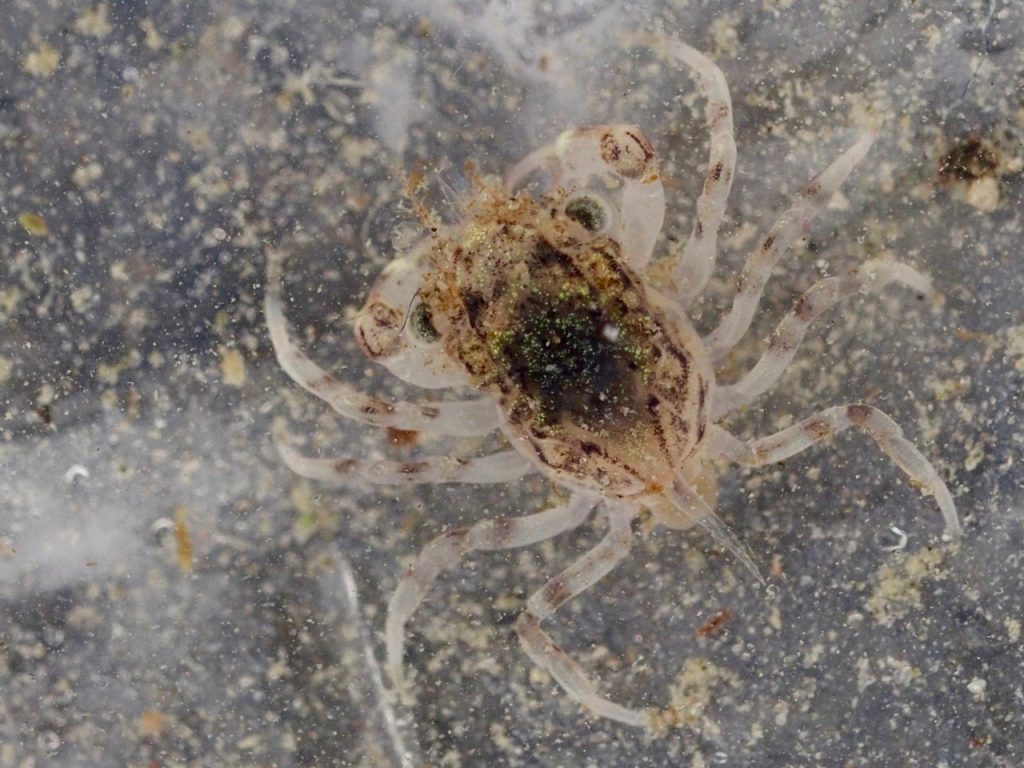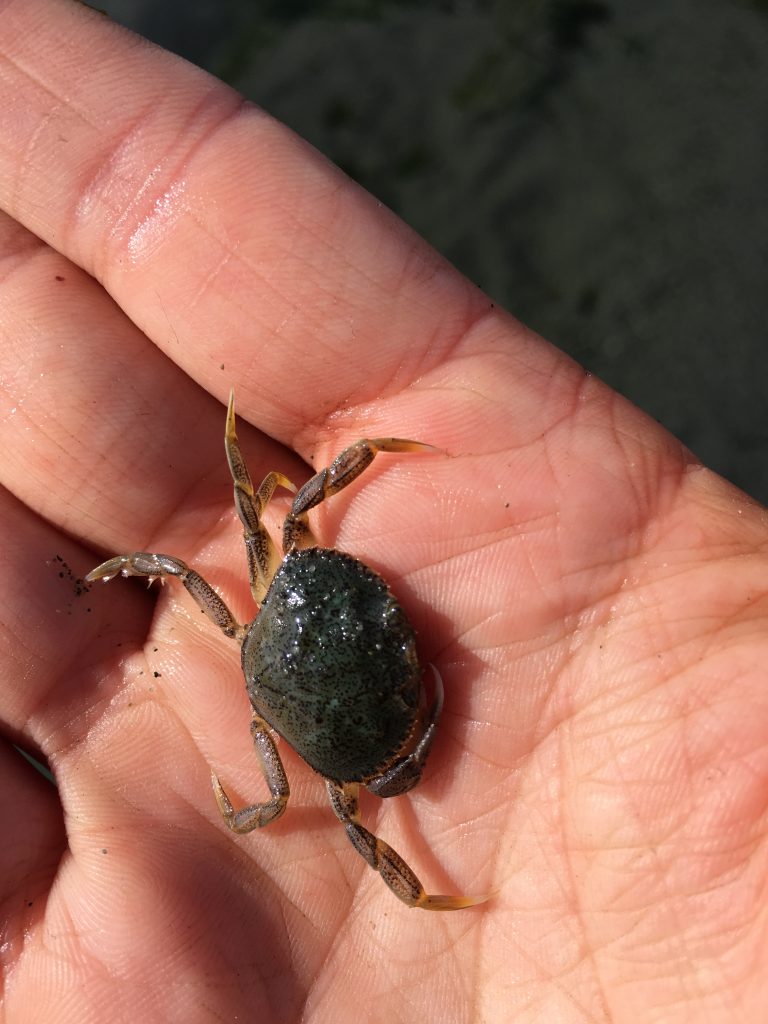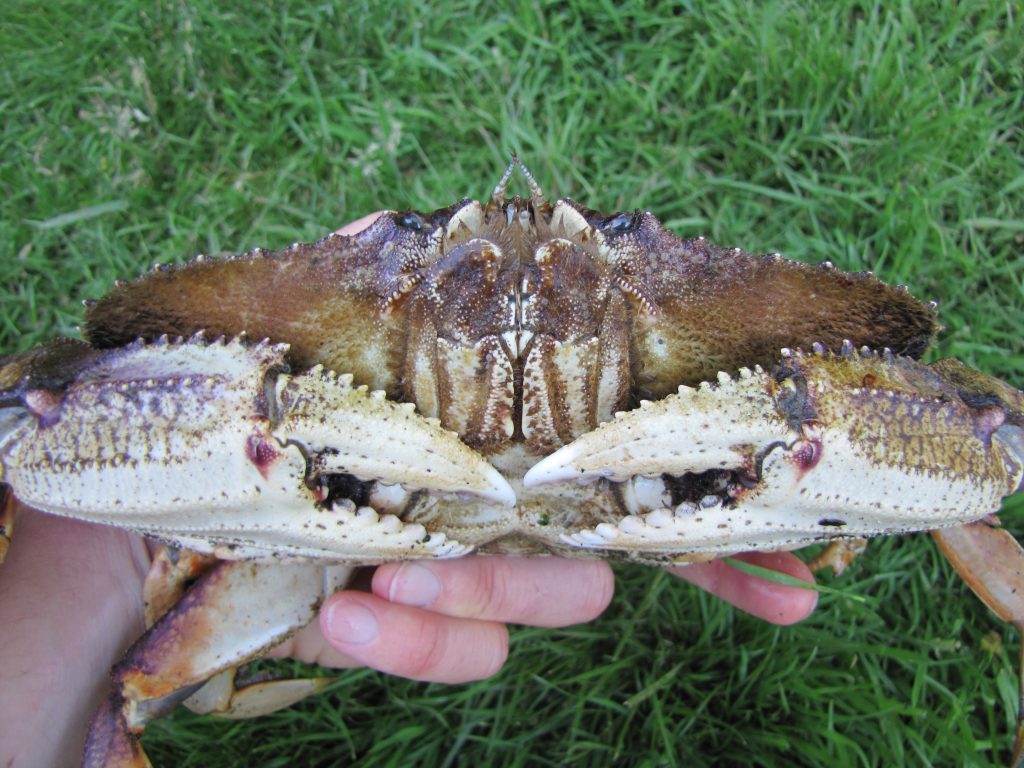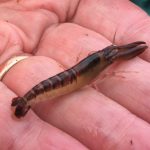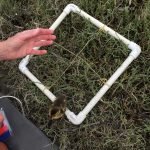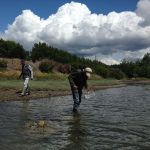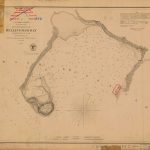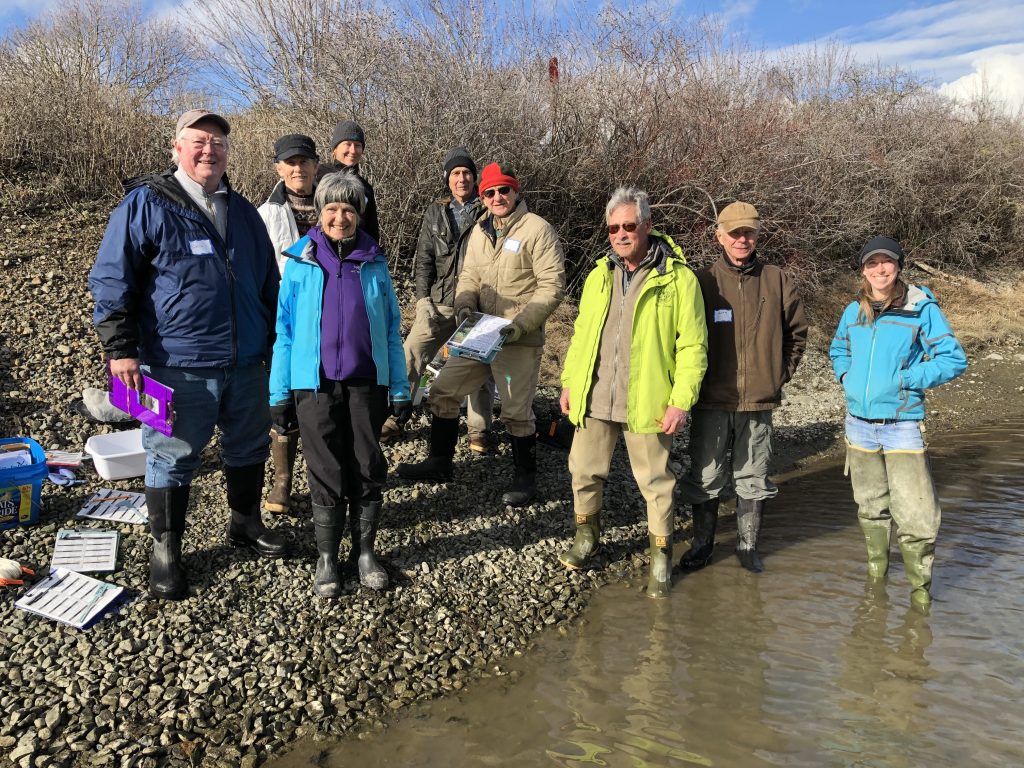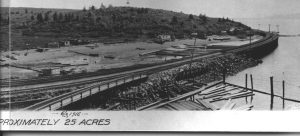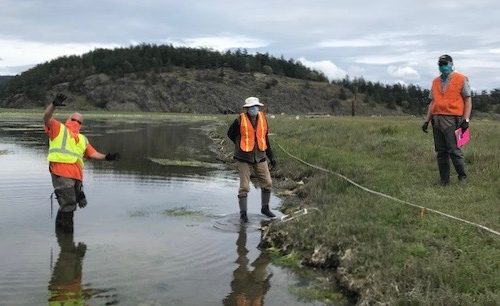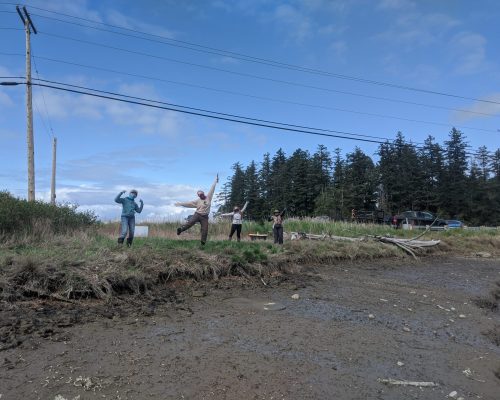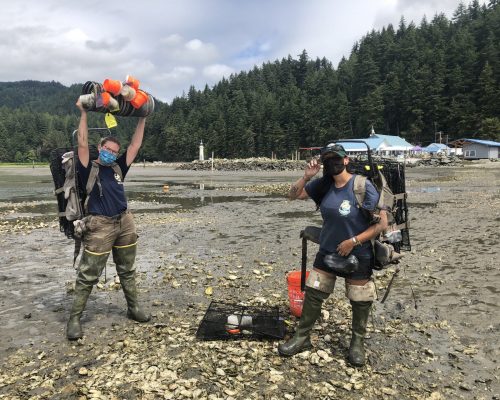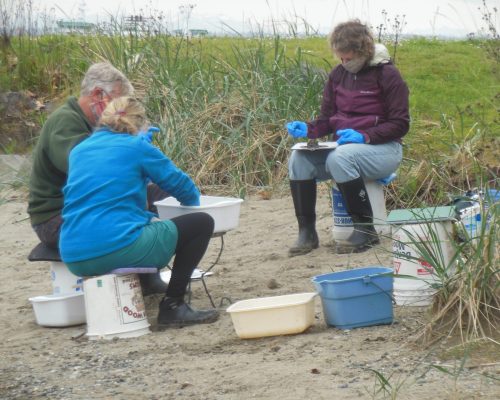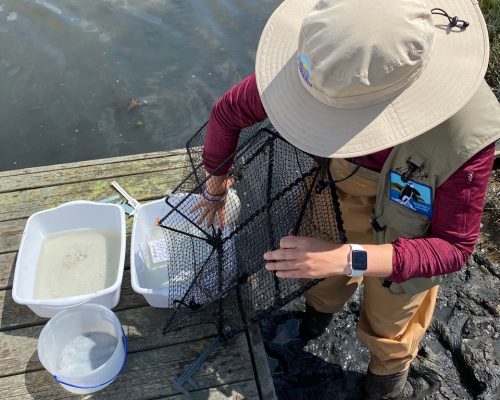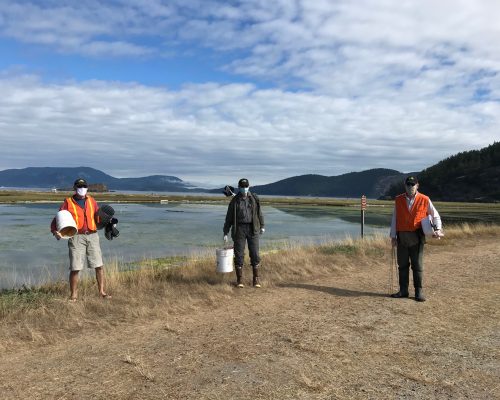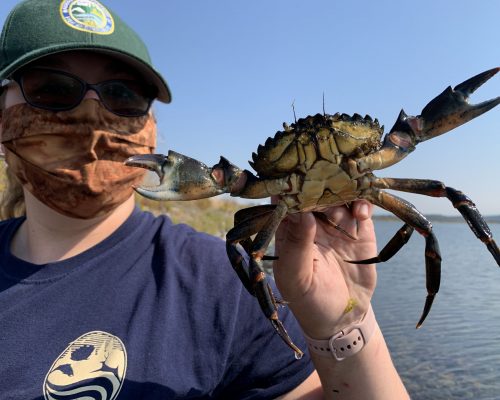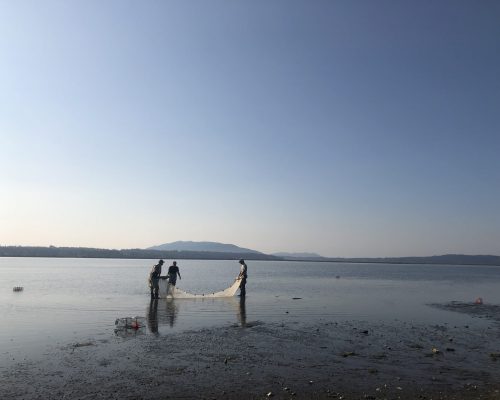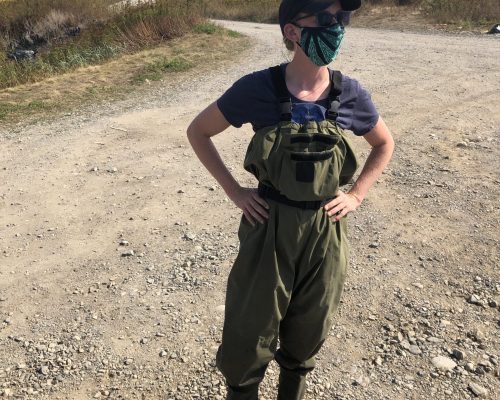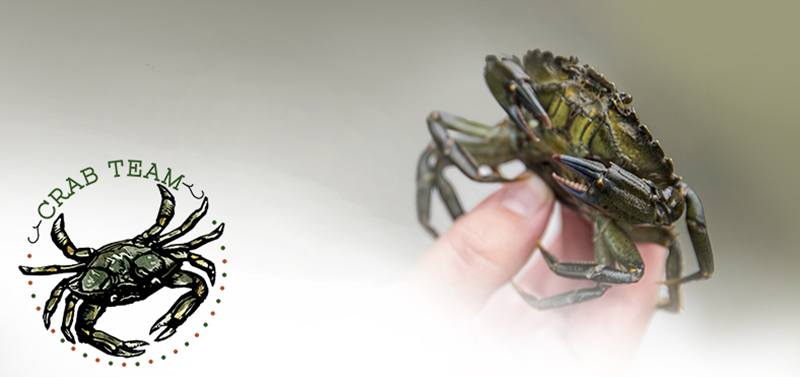
Committed Crabbers
November, 2020
This year was already poised to be exceptionally busy for WSG Crab Team and the management of the European green crab invasion in Washington – even before we were faced with a global pandemic. Through last winter, facing new detection sites in Whatcom County, and increasing reports of green crab on the Pacific coast of Washington, Crab Team was collaborating with Washington Department of Fish & Wildlife to substantially expand management capacity. Now, as we take our seasonal pause in trapping, and reflect on what we did manage to accomplish in spite of all the obstacles 2020 has thrown at all of us, we are proud to share a few of the highlights, including:
- Training a total of seven new WDFW and WSG personnel, as well as partner staff with agencies and tribes, to trap green crabs.
- Launching a removal trapping program in Drayton Harbor in collaboration with WDFW and the Northwest Straits Commission.
- Initiating an assessment of green crab populations along Washington’s Pacific coast.
Unfortunately, one area we weren’t able to grow this year was the Crab Team volunteer corps. COVID-related closures hit just before the annual round of training workshops, meaning teams had to rely on continuing participants to complete the regular monthly monitoring from April through September. Returning Crab Team volunteers were equal to the task, gracefully navigating added safety measures to complete more than 90% of regular monitoring efforts! This is, to our minds, the biggest success of the year. We look forward to getting creative in 2021 to figure out how to best train new volunteers and help provide reinforcements for the steadfast teams who carried the torch this year.
The threat from green crabs hasn’t let up during the pandemic, but neither have the incredibly dedicated volunteers and staff who together manage green crab in Washington. We’re unendingly grateful and lucky to be in the mud with folks who are so dedicated to protecting shorelines.
All our pinchy best,
Crab Team HQ
Green Crab: Larvae on the move
Guest contributor Elizabeth Brasseale is currently a postdoctoral fellow at Scripps Institution of Oceanography. As part of her Ph.D. research at the UW School of Oceanography, she worked on a project with Crab Team to help us learn about how green crab larvae may be moving into and around the Salish Sea. In this feature, she describes the results of that research.
In 2016, the first European green crab sighting was confirmed in the eastern Salish Sea, in Westcott Bay in the San Juan Islands. However, at that time, green crabs were not entirely new to the Pacific Northwest. Green crabs had been sighted in bays on the outer coast of Oregon, Washington and British Columbia as early as 1997. So why didn’t green crabs reach the Salish Sea earlier?
Green crab can spread to new places by releasing their young (larvae) into the ocean currents, where they can travel hundreds of miles over the weeks they spend as plankton. By and large, plankton are obliged to go wherever the ocean takes them, so they can only reach new places if there is a pathway in the ocean currents carrying them there. Ocean currents are highly changeable, so these pathways appear and disappear with the tides, weather, seasons, and large ocean trends like El Niño. To find out how green crab larvae are (and aren’t) getting into the eastern Salish Sea, we need to know where and when these pathways are open. To do this, Crab Team joined up with the Coastal Modeling Group at the University of Washington School of Oceanography, where researchers operate a computer model of the Salish Sea and the neighboring areas of the Pacific Ocean. The plan was to use the computer model to see where the pathways were in 2014, 2015 and 2016, the years leading up to the first Westcott Bay sighting.
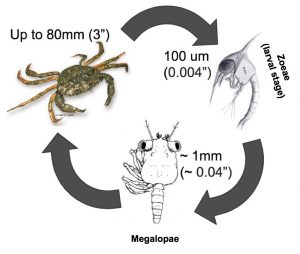
Life stages of European green crab. With adapted images from Greg Jensen (adult), Rice and Ingle (megalopa), and Haeckel (zoea).
Well, How Did They Get Here?
There were two hypotheses for how green crabs arrived in the eastern Salish Sea. One possibility is that they came from infested bays on the coast of Washington, Oregon or Vancouver Island. Green crabs have occupied these bays for the last few decades, but it appears their spread into the eastern Salish Sea may have initially been avoided because the Strait of Juan de Fuca forms a natural barrier. The Strait of Juan de Fuca is usually a one-way street carrying a huge amount of freshwater from the Puget Sound watershed and the Frasier River out to the Pacific Ocean, and preventing crab larvae, poor swimmers that they are, from getting washed in. That “barrier” can be removed, however, when the wind is strong enough to reverse the direction of flow in the Strait of Juan de Fuca. But this phenomenon most often occurs in winter so, in general, there is a mismatch between the times when green crab reproduce (spring and summer) and the times when flow reverses in the Strait of Juan de Fuca (fall and winter). Therefore, the hypothesis is that the green crab populations in the region have always posed a threat to the eastern Salish Sea, but it was so unlikely for the timing of green crab larval release to align with a flow reversal in the Strait of Juan de Fuca that it took twenty years before such a coincidence occurred.
The second hypothesis is that green crab invasion in the eastern Salish Sea was inevitable after humans accidentally introduced green crabs to Sooke Basin sometime before 2012. Small green crabs hitched a ride in bags of mussels brought for biotoxin monitoring to Sooke from Clayoquot Sound, a bay with an established green crab population on the west coast of Vancouver Island. For its size, Sooke Basin has a very small opening to the Strait of Juan de Fuca, so water in the basin tends to recirculate rather than empty into the Strait. This allows Sooke to retain a lot of the green crab larvae released by crabs living there, which meant that a large, isolated population grew quickly from the initial introduction. By potentially enabling larvae to bypass the barrier posed by the Strait of Juan de Fuca and accelerating spread in the Salish Sea, the green crab population at Sooke has been of particular concern to managers.
Was Sooke “pouring” green crab larvae into the eastern Salish Sea, or did it mostly keep all its green crab larvae to itself? Was green crab in the eastern Salish Sea an unlucky coincidence, or inevitable?
Experiments “in Silico”
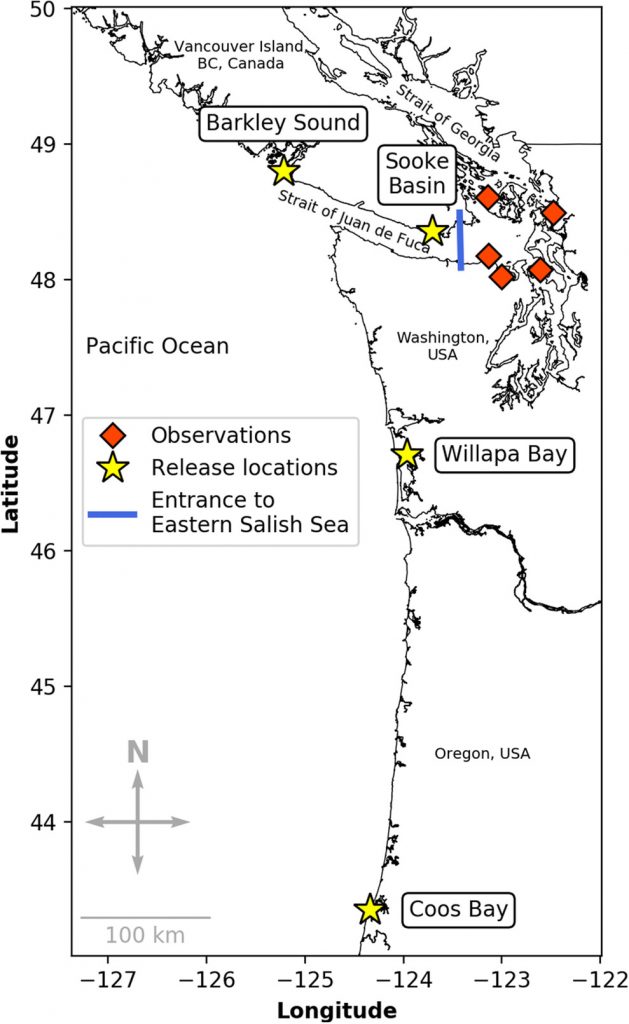
Map of study area. The eastern Salish Sea is delineated from the Strait of Juan de Fuca by a blue line. Orange diamonds represent confirmed green crab observations in the eastern Salish Sea and yellow stars mark larval release locations. Figure from Brasseale et al. 2019. Click to enlarge.
To answer these questions, we conducted experiments using the UW Coastal Modeling Group’s computer model, LiveOcean. We started by recreating the ocean conditions in the Pacific Northwest during 2014–2016, the period when the larvae of the crabs detected in the eastern Salish Sea starting in 2016 would have actually arrived at those sites. For our test sites, we chose Sooke Basin and three other bays where green crabs have been found since the late 1990s that would represent a range of possible geographic origins: Coos Bay (OR), Willapa Bay (WA), and Barkley Sound (BC).
Then we simulated green crab larval releases on several dates during their observed spawning season and used the model to track where they would have ended up. This was done by assigning 10,000 virtual larvae a starting place in the ocean near the mouth of each of the test sites. The simulations checked the direction and speed of the ocean currents at each larva’s location every hour, and moved the larva to a new location accordingly, imitating the way green crab larvae drift as plankton, going wherever the ocean takes them.
Surfing the Salish Sea
We found a number of surprising results. First of all, green crab larvae could reach the eastern Salish Sea from any of the four sites we tested, but it was a rare occurrence. At every test site, some fraction of the virtual larvae released found a pathway into the Salish Sea on at least one release date, even from as far away as Coos Bay. But, for all of the test sites, there were also some release dates for which no virtual reached the eastern Salish Sea. Often, only a very small fraction of the 10,000 virtual green crab larvae released made it to the eastern Salish Sea.
Was Sooke, the closest test site, significantly more likely to be responsible for the green crabs found in the eastern Salish Sea? Surprisingly, it was not. For all of the experiments run for Sooke Basin, only 1.73% of the virtual larvae released made it to the eastern Salish Sea. The Oregon test site, Coos Bay, which was most distant, had a similar result, with 1.86% of virtual larvae released from Coos reaching the eastern Salish Sea. The most likely site was actually Willapa Bay, from which 3.06% found a way into the eastern Salish Sea. That means that green crab larvae that were spawned in Willapa Bay were almost twice as likely to reach the eastern Salish Sea as larvae that spawned in Sooke. The least likely test site was north of the Strait of Juan de Fuca at Barkley Sound, from which only 0.46% of virtual larvae ended up in the eastern Salish Sea.
Although larvae from some sites were, on average, slightly more likely than others to get swept into the Salish Sea, the differences were not large or consistent enough to conclude that any one site had the most direct pathway. Additionally, when you consider other factors like the size of the adult green crab populations at each site, the picture gets murkier. Willapa Bay, which had the highest overall percentage of virtual larvae that got in, also had the smallest population of adult green crabs of the test sites during those years. So, there might have been a pathway from Willapa to Westcott Bay at the right time, but there might not have been any larvae to take that path. That is to say, these results don’t provide us with a smoking gun for a single source population for green crabs that have been found to date along the inland shorelines.
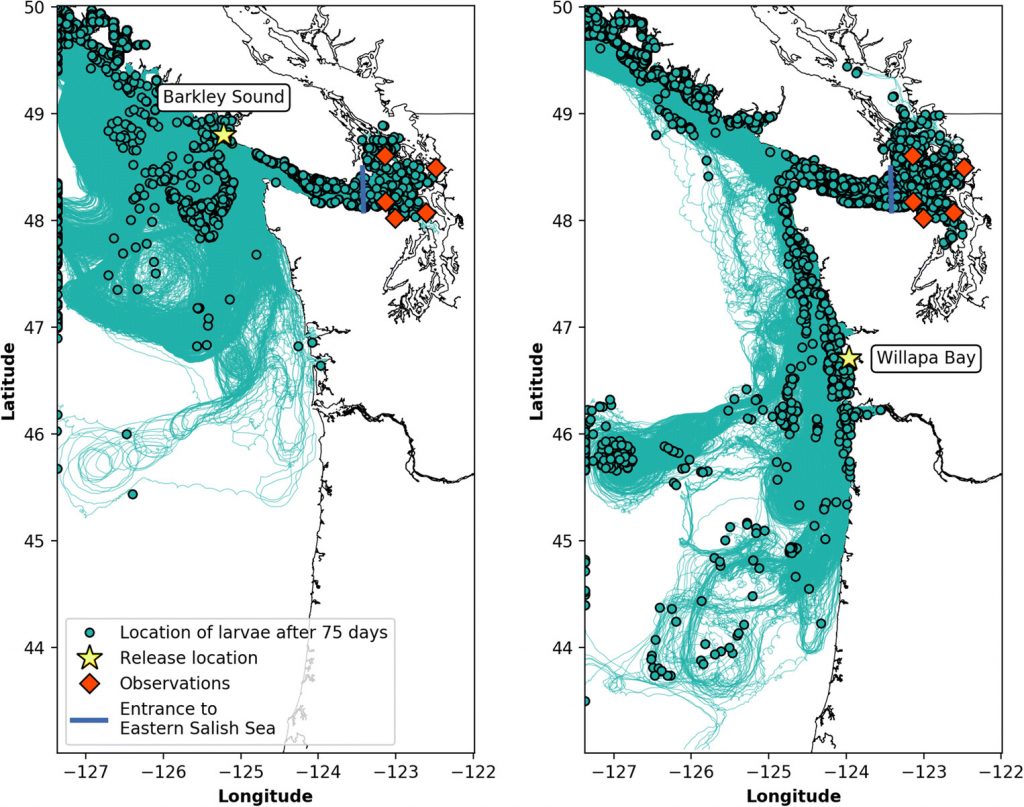
Computer models simulated the pathways of larvae released on August 10, 2014. In these examples, about 4% and 27% of electronic larvae were successfully transported into the eastern Salish Sea from Barkley Sound (BC) and Willapa Bay (WA), respectively. Figure from Brasseale et al. 2019. Click to enlarge.
No Smoking Gun for Salish Sea Green Crabs
What these results do tell us is that, overall, it was hard — but possible — for green crab larvae from all over the Pacific Northwest to reach the eastern Salish Sea in 2014, 2015 and 2016. Considering all experiments at all sites, 2 out of every 100 virtual larvae found a pathway into the eastern Salish Sea. Sooke was not the obvious culprit we had suspected and was only as likely as any other site to be responsible for the green crab found in the eastern Salish Sea. It is worth noting that 2014–2016 were the Warm Blob years and featured a strong El Niño, which is known to facilitate the spread of marine invasive species. Ocean heat waves such as these, which are not ordinary but are becoming more frequent as the climate changes, may open more paths for green crab larvae into the Salish Sea.
The most important conclusion from this work is that the waters of the Pacific Northwest are even more connected than we realized. Therefore, our efforts to protect the Salish Sea can have far-reaching implications.
– Elizabeth Brasseale
Citation: Brasseale E, Grason EW, McDonald PS, Adams J, MacCready P (2019) Larval transport modeling support for identifying population sources of European green crab in the Salish Sea. Estuaries and Coasts. Vol 42:1586-1599. DOI: https://doi.org/10.1007/s12237-019-00586-2

Hear the word “crab” and what do you picture? For must of us, it’s a Dungeness crab – a well-known, abundant predator in the nearshore waters of the Salish Sea and outer coast, as well as the target of important commercial, recreational and subsistence fisheries. It is also as quintessentially Northwest as salmon and orcas. In fact, the crab gets its common name from the Dungeness area (Dungeness River and Dungeness Spit) along the northern Washington Coast of the Strait of Juan de Fuca. It was in this locale where the first commercial fishery began in 1848, making it the oldest shellfishery in the northeastern Pacific. Since that time, the fishery has grown to be among the most valuable in the United States; in 2016 it was ranked sixth out of all U.S. fisheries, with a value of more than 222 million dollars (NOAA 2018).
Of course, the native peoples of the region have recognized the crab’s value for millennia, and oral histories and midden excavations indicate it was an important “beach food” from Alaska to central California. Typically, native harvesters would wade into shallow water and gather crabs by hand. In some places, fishermen would wear cedar bark visors to shield their eyes from the water’s glare and skewer their skittering quarry with short, wooden spears. Rakes may also have been used to efficiently harvest large numbers of crabs; one midden at an ancient village site in Netarts Bay, Oregon, contained the remains of more than 14,000 crabs across a range of sizes (Losey et al. 2004). Traditionally, crabs were steamed in sand-lined pits on the beach long before the iron or aluminum pots of the modern crab boil. Native peoples called the crab different names in different places: hasaamats (Mahousat), galmoos (Port Simpson), and Xíxyik’ (Coast Salish), among others.
A Deep Dive into Dungies
At Crab Team, we call this particular crab MEMA; shorthand for the scientific name of the species – Metacarcinus magister. It’s not even close to the most abundant crab in our sampling efforts, but MEMA is an important seasonal resident of pocket estuaries. The life history of MEMA can be divided into four distinct phases characterized by changes in growth, behavior and habitat. These include the larval phase, juvenile (up to a year old), subadult (the awkward ‘teen’ years; 1 to 3+ year olds), and adult (>3+ year olds). While there is seasonal variation in this life history across the range of the species from Alaska to southern California, the general pattern is consistent (Jensen 1995). Timing is predominantly dictated by changes in light and temperature.
MEMA, like many other marine creatures, has an ocean-going larval phase that can disperse hundreds, if not thousands, of miles. Newly hatched larvae enter the water column as zoeae, which look more like a mosquito than a crab, and spend months drifting on ocean currents (Buchanan and Milleman 1969). Their survival, and the overall duration of their early development, is dependent on water temperature and available food (Buchanan and Milleman 1969; Reed 1969, Moloney et al. 1994, Lough 1976, Sulkin et al. 1998a). To grow up big and strong, these zoeae need a fatty, or lipid-rich diet, including smaller phyto- (plant) and zoo- (animal) plankton. If conditions are right, the zoeae transition through five stages, each looking slightly more crab-like than the previous one. Throughout this early phase the zoeae are at the mercy of the winds and currents; sometimes they’re carried along the coastlines and other times farther out to sea (Shanks 2009). They are weak swimmers overall; however, by swimming upward or downward in the water column in response to light, they can influence the overall direction of their movement (Shanks 1986, Johnson et al. 1986, Moloney et al. 1994). With a little luck the zoeae will remain close to shore and in the general vicinity of good bottom habitat as they near their next transition.
When the time is right, zoeae metamorphose into a short-lived megalopae stage (Poole 1966), which looks like a cross between a lobster and a tadpole (author’s note: they are adorable). Unlike zoeae, megalopae don’t feed. The sole purpose of this unusual life stage is to find suitable settlement habitat, and they are well-equipped for the task. Literally bristling with sensory organs, megalopae smell, taste and feel their way around for up to two weeks. The chickpea-sized megalopae are also proficient swimmers and frequently swarm at the surface in nearshore areas, where they await environmental cues that lead them to good habitats. Choice experiments done by UW researchers show that megalopae prefer complex shell and eelgrass over sandy or muddy bottoms (Fernandez et al. 1993). This preference is critical because the process of transition to bottom-dwelling life is fraught with peril, and an unlucky juvenile crab caught out in the open would make a quick snack for a larger predator (Armstrong et al. 1995).
Mobile MEMA
Juvenile MEMA completely depend on shell and eelgrass habitat in many estuaries. A dearth of these critical nursery habitats can severely limit local MEMA populations. Juvenile crab feed entirely within protective habitats and compete for space with each other (Iribarne et al. 1994), hairy shore crabs (Visser et al. 2004), and potentially even small European green crabs. Juvenile crabs inhabit intertidal shell and eelgrass for about 2.5 months during their first summer, grow rapidly through the first 4-5 molts (Dumbauld et al. 1993), then emigrate from these intertidal habitats to subtidal locations because of changes in diet and physical tolerances (e.g. temperature, salinity).
Subadult MEMA are sometimes captured during Crab Team monitoring efforts. These 1+ to 3-year olds typically occur in sandy nearshore areas that are usually less than 60 feet but sometimes as much as 120 feet in depth (Tasto 1983, in Wild and Tasto 1983). Subadult crabs tend to be most numerous in estuaries, where individuals take advantage of abundant food and grow quickly in the warm, shallow water. Their appetites can dramatically impact local ecosystems. For instance, in Willapa Bay, Washington’s largest coastal estuary, abundant subadult crabs ravenously consume all available prey and are forced to migrate with the rising tide more than 0.5 mile or more to scour the tideflats for food (Tasto 1983, in Wild and Tasto 1983). Once crabs reach sexual maturity at about 2-3 years of age (Gutermuth and Armstrong 1989), they migrate to deeper waters.
Adult MEMA are not common in intertidal areas and shallow pocket estuaries, and generally prefer deeper subtidal habitats of coastal and inland waters. While capable of walking long distances (Collier 1983, in Wild and Tasto 1983) most adult males are relatively sedentary and only migrate inshore to mate during the spring and summer (Gotshall 1978). Similar patterns have been observed for females; in a study conducted in northern California, researchers (Diamond and Hankin 1985) recovered about 46% of tagged female crab within about 1 nautical mile of their release location after one year. Females also move inshore to shallow sandy areas during the spring, possibly because of molting, mating or to brood their eggs. There is even some evidence that egg-bearing females (Armstrong et al. 1987) exhibit site fidelity and may return year after year to the same brooding locations and form large partially buried groups in sand habitats (Armstrong et al. 1987).
Pocket Estuary Team players
Along with being important predators (Gotshall 1977), MEMA are valuable prey (Reilly 1983, in Wild and Tasto 1983) to more than just humans! Zoeae are eaten by a variety of animals, including planktivorous fishes (Stevens et al. 1982). The larger, more conspicuous megalopae are a particular favorite of Chinook salmon (Hunt et al. 1999). Bottom-dwelling juveniles are common in the diets of fishes, including Pacific hake, sablefish, Dover sole (Buckley et al. 1999), staghorn sculpin (another Crab Team favorite) (Armstrong et al. 1995), and copper rockfish (Prince and Gotshall 1976). Birds, such as white-winged scoters (Grosz and Yocom 1972), and mammals, including river otters and raccoons, opportunistically consume small crab at low tide (Larson 1984). By the end of their first or second year, MEMA are too large for most predators to subdue. Nevertheless, they are still consumed by large fish, such as white sturgeon and cabezon, wolf eel, lingcod and various rockfish (Gray 1964) and even white shark. MEMA have also been recorded in the diets of marine mammals such as sea otters (Laidre and Jameson 2006).
Despite this gauntlet of hungry mouths, MEMA continue to thrive in pocket estuaries and elsewhere. The biggest threats to the species remain human-caused: loss of estuarine habitat in places like San Francisco Bay and the degradation of shell and eelgrass nursery habitats, as well as changes in water temperature and chemistry associated with rising temperatures and ocean acidification (Armstrong et al. 2010 in Kruse et al. 2009). The health and vitality of MEMA populations largely depends on how we address these larger challenges.
– P. Sean McDonald
**While we try to link you directly to the research we reference, some of the studies cited in this article are not open access. If you have any questions about any of the works cited here, please feel free to reach out to crabteam@uw.edu.
If you peruse the Crab Team archives of annual infographics, you might notice that one site name pops up repeatedly with the superlative of greatest diversity of animals trapped: Post Point. Tucked between Bellingham’s wastewater treatment facility and a railroad trestle, this pocket estuary lagoon in Fairhaven might not be your first guess as the title-holder for the greatest number of species in the traps for three of the last four years.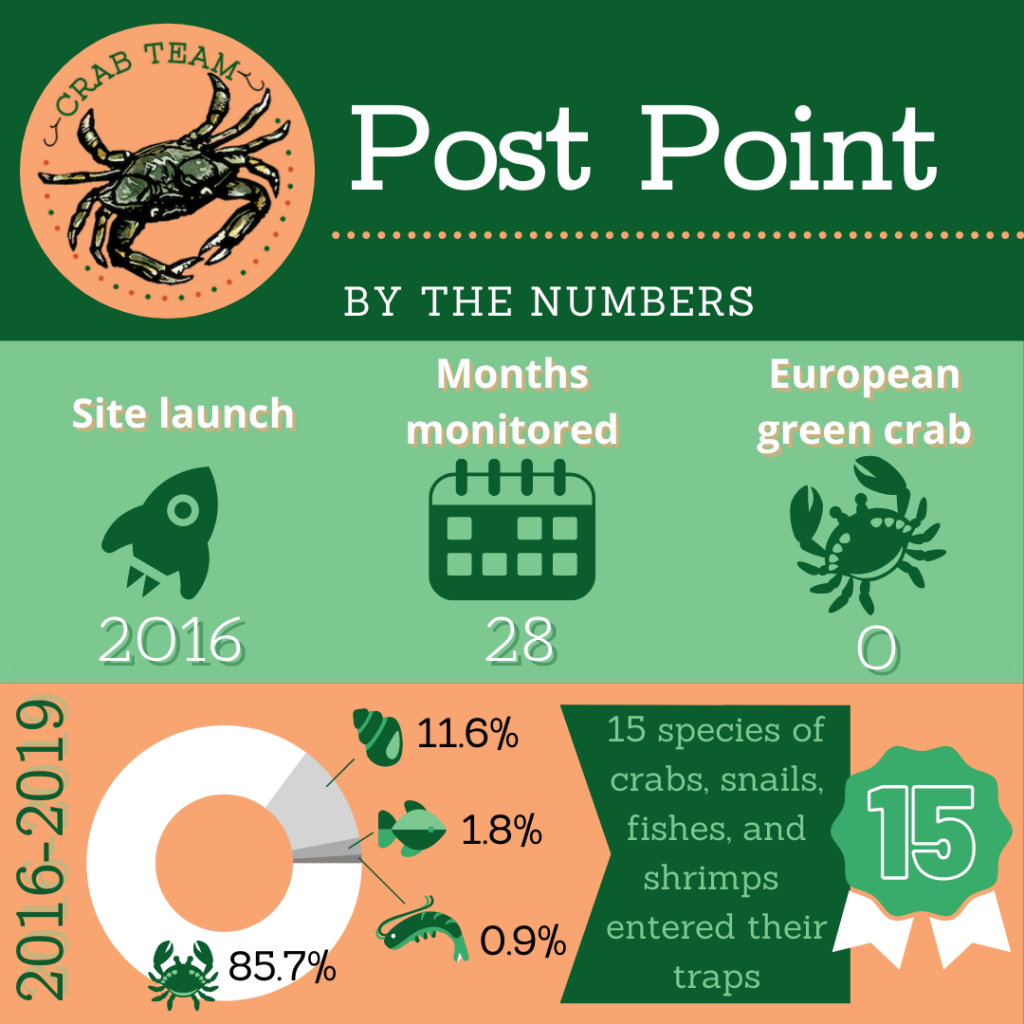
In total, volunteers working at the site have identified 15 species of crabs, snails, fish and shrimps that have entered their traps (including the only snapping shrimp ever caught in Crab Team sampling) — and that doesn’t include the algae, eelgrass, and animals that don’t enter traps but nevertheless enrich the lagoon. For example, it turns out that Post Point is home to one of only two documented populations of the rare native Olympia oyster (Ostrea lurida) in Whatcom County — and the presence of our State bivalve at this site was first uncovered by Crab Team volunteers!
Crab Team data also don’t capture the waterfowl that rest and raise their young in the lagoon, or the herons nesting in the heronry overhead.
Meet the Post Point Crabbers
The volunteer crew at Post Point is particularly well equipped to capture this diversity, as the team members have a wealth of local shoreline expertise. Team captain Bob Cecile sits on the Whatcom Marine Resources Committee (MRC) and actually participated in the previous volunteer-based effort to monitor for European green crabs prior to 2010 (MISM).
Glen “Alex” Alexander, also an MRC member, was the outreach and education coordinator at Padilla Bay National Estuarine Research Reserve prior to retiring a few years ago. In fact, it was Alex who found the first European green crab in Padilla Bay in 2016, hot on the heels of the first-ever detection in inland Washington on San Juan Island that same year. Alex cites his motivation for staying involved in all things green crab, including volunteering with the Makah Tribe and the Drayton Harbor assessment last fall, as the draw of actually getting his hands on the dang crabs! About Crab Team in particular, he adds, “It is good science….that really does bring great fulfillment to me.“ Crab Team brings people together seeking the camaraderie of working alongside others who value the rigorous and careful work needed to make sense of complex ecological questions. In a funny coincidence, Alex and teammate Bob Lemon realized that they had worked together on a lab team counting snails back at Huxley College decades ago! Post Pointers are generous to bring their depth of experience in education, marine stewardship and natural history to Crab Team.
An Evolving Site
The present richness of life is a welcome site at Post Point. On the ancestral lands of the Lummi and Nooksack peoples, the site has transformed, evolved and reemerged several times in new guises. For, as rich as is the marine community, so is the history of Post Point, also known as Poe’s Point (or Graveyard Point … or Deadman’s Point depending on your timeline). The point was at one time much taller, a glacial moraine. During the settler years, the clearing and leveling of the area for use as a boatyard, the construction of the railroad, and the excavation of the lagoon, all transformed the landscape, creating the pocket estuary sampled today.
The most recent stage of Post Point’s evolution is “restoration success.” Fifteen years ago, the site was suffering from too much love. It was a popular spot for dogs to fetch and play in the water, and too many paws and feet in such a small area trampled the shoreline and aquatic vegetation. For four years, the City of Bellingham, who currently owns the site, installed paved trails and fences, and designated a protection zone for the lagoon, to enable dogs and their humans to enjoy it from a safer distance. They replanted the riparian zones and even eelgrass within the lagoon. The recovery has been textbook, with vegetation filling in along the shoreline, improving water quality, and, as Crab Team monitoring has documented, the lagoon now supports one of the richest pocket estuary faunas across our 56-site network.
Restoration Ideal
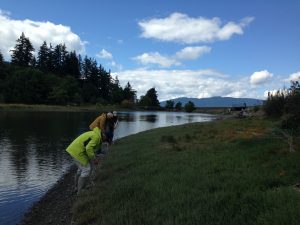
Post Point volunteers expertly assess shoreline habitat in a monthly transect survey. Photo courtesy of Emily Grason.
While the lagoon is largely considered ecologically restored, the site will likely never return to its pre-colonial condition. The railroad tracks that retain the lagoon itself continue to guide freight and passengers between Seattle and points north. Post Point’s ecological community also now hosts several species unknown to this part of the world prior to Western colonization, including the Asian mud snail (Batillaria attramentaria) and the Japanese oyster drill (Ocenebrellus inornatus). Both were imported unintentionally with Pacific oysters (Crassostrea gigas) and the drill can be a threat to native oyster populations. In a lot of ways Post Point carries out the new ideals of restoration, which prioritize recovering ecological function across a landscape, rather than trying to recreate some estimate of what a given site was like prior to degradation by humans.
So far, European green crabs have not been detected among the other newcomers found at Post Point. Four years of trapping has failed to detect them at that site*. This gives us some hope that the lagoon can be protected into the future. Though Post Point will undoubtedly continue to evolve in the coming decades, and we hope to see an even greater diversity of animals there, we dearly hope that European green crabs are not soon added to its list of species.
Crab Team is grateful to the City of Bellingham for permitting access to the site for early detection monitoring.
*In addition to four years of Crab Team early detection monitoring, in 2019, Washington Department of Fish and Wildlife conducted two nights of intensive assessment trapping in the lagoon, in response to detecting three green crabs in nearby Chuckanut Bay. A follow-up assessment this year in September yielded no evidence of European green crabs.
-Emily Grason
Photo Gallery
We love to get the virtual experience of monitoring with all of the Crab Team volunteers. Do you have a photo to share? Send it to crabteam@uw.edu. (Click on arrows to scroll, and photos to enlarge for more detail.)
